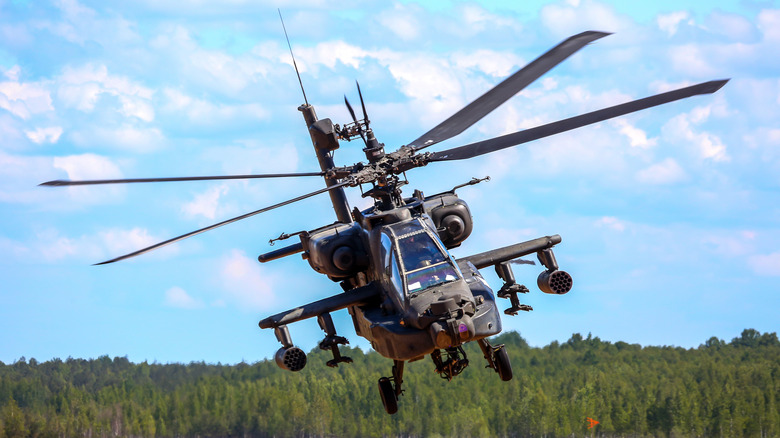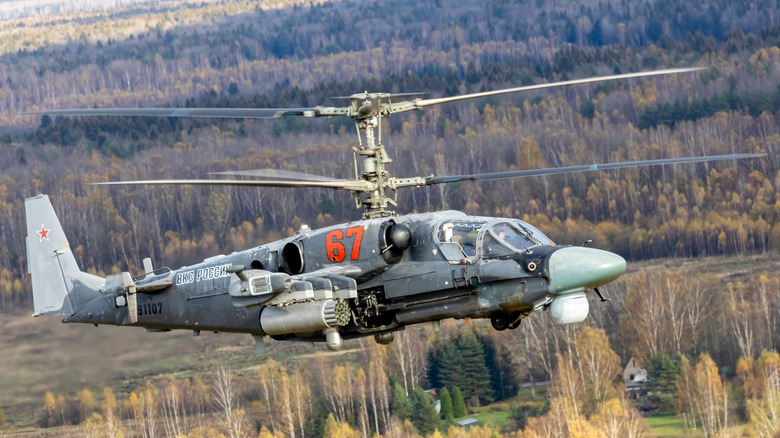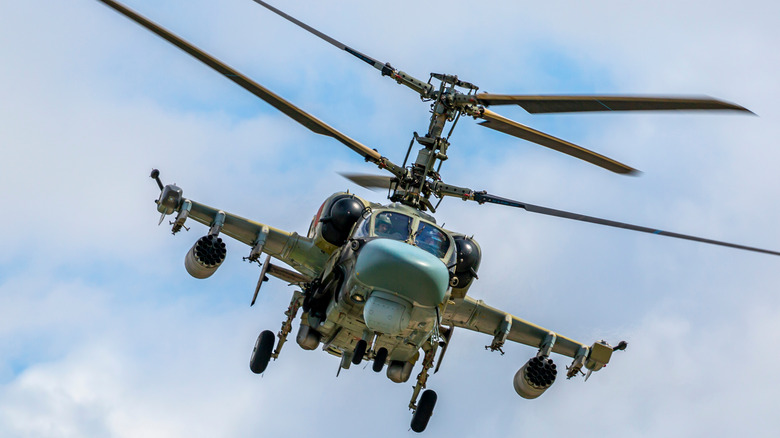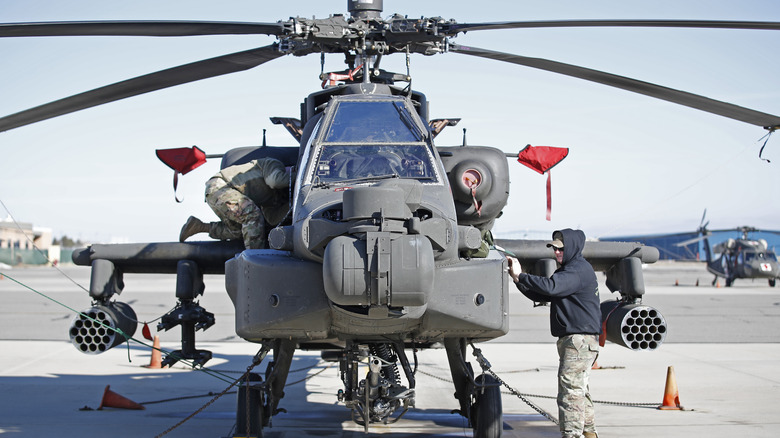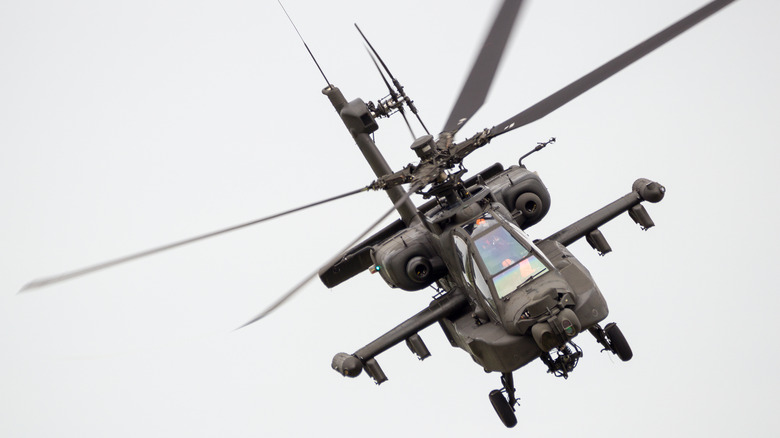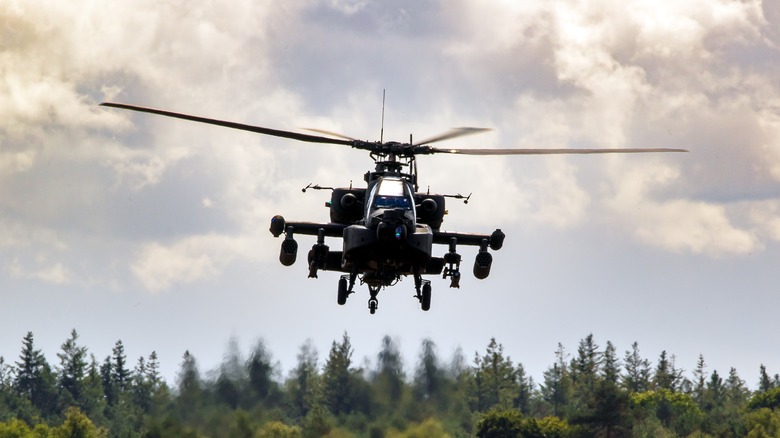Kamov KA-52 Alligator Vs AH-64 Apache: Which Fighter Helicopter Is Better?
Next to the M1 Abrams, the AH-64 Apache attack helicopter is a symbol of the United States' military might. It's essentially a flying gun and missile platform meant to deal with whatever threats are thrown at it. Similarly, the Kamov KA-52 "Alligator" (also called "Hokum" by NATO) is emblematic of Russia's post-Cold War fighting ability. Although the two attack helicopters have never faced each other in combat, it's still worth taking a look at each chopper's combat abilities and performance metrics.
Although unlikely, it's not entirely impossible that global tempers arise to the point where both the Alligator and Apache see each other on opposite sides of the battlefield, especially with the influx of American and NATO-sourced equipment taking part in the war in Ukraine. Although the cessation of the Cold War lessened the chances of American and Russian forces directly attacking each other in open combat, the KA-52 and AH-64 were ostensibly made to fight each other.
The Alligator
The Kamov KA-52 Alligator first took to the skies in 1997, but began full production in 2008. However, its design goes back to the 1980s. The KA-52 is actually a heavily modified and upgraded version of the earlier KA-50 Black Shark attack helicopter. That helicopter has been around since 1982. The Black Shark, however, never made it past the early production stage and saw limited service with only around a dozen ever leaving the production line.
At first glance, you'll notice that not only is the "Alligator" name apt (note the long nose and fuselage), it doesn't have a vertical tail rotor like most other helicopters. Instead, it boasts two contra-rotating rotors stacked on top of each other. Despite how it looks, the Kamov doesn't deploy this rotor formation just because it looks cool. According to the U.S Army, the Kamov's propellors allow it to turn at speed without favoring either side. This allows weapons to stay on target longer and generally provides for more agility compared to other more conventional helicopter rotor setups.
The Alligator is powered by two turboshaft engines that make a combined 4,800 hp. For performance, the Alligator tops out at 192 miles per hour when flying flat.
Russia's attack chopper
As far as weapons go, the Kamov can be equipped with just about any munitions the mission requires. That includes unguided S-8 rockets, of which the Kamov can carry up to 80. Or, it can be fitted with air-to-air missiles for taking out other helicopters or low-flying fixed wing aircraft. Additionally, anti-tank guided missiles can be mounted under the Kamov's "wings."
One of the more notable weapons that can be fitted to the Kamov is a side-mounted autocannon. The Shipunov 2A42, as it's called, has been fitted to armored personnel carriers and other attack helicopters. It's been around since "somewhere in the 1970s," according to the U.S. Army archives and was used by several militaries before and after the cessation of the Cold War. The Shipunov 2A42 is a 30-millimeter cannon that can fire upwards of 800 rounds per minute, but can be set to different fire rates. The main ammunition fired is a armor-piercing high explosive incendiary round.
The Apache
The main attack helicopter for the U.S. military is the Boeing AH-64 Apache. It has been in production since 1984 including all variants and is sold across 16 additional countries. Unlike the Kamov, it's a more recognizably shaped helicopter, possessing a main horizontal rotor with a smaller vertical rotor on the tail. It's powered by a pair of General Electric turboshaft engines that make a for nearly 4000 hp. It carries a top speed of more than 183 miles per hour.
Apache helicopters have seen extensive combat, particularly in the Middle East during all phases of the First and Second Gulf War as well as the War in Afghanistan. The current version, the AH-64E Apache Guardian has been in active use since 2012. It's equipped with UAV capabilities and upgraded communications. Future versions that improve the speed and maneuverability like the AH-64F or Compound Apache are currently in development. The Compound Apache's top speed is theorized to be approaching 213 miles per hour.
A flying supercomputer
One of the most recognizable armaments of the Apache is the "chin" mounted gun. It's an M230 chain gun developed by McDonnell Douglas and it typically fires a 30-millimeter high-explosive round. On its wing-mounts, it can carry AGM-114 "Hellfire" guided missiles and a complement of Hydra unguided rockets. Rockets and a chain gun are certainly competitive on a modern battlefield, but the Apache's real lethality lies in its avionics and computerized systems.
According to the U.S. Army, the AH-64E's wide variety of communications arrays, sensors, and radars can detect upwards of 256 targets at any given time and feed that information to troops on the ground, UAVs in the air, Naval forces, or the pilots themselves. The Apache can not only act in an offensive role when needed, it can also serve as an eye in the sky. The aircraft itself had the ability to prioritize targets. The Army notes that future production AH-64Es will include "a cognitive decision aiding system and new self-diagnostic abilities." The specific way that such systems operate, however, will likely remain classified.
Boeing calls the AH-64 "The world's most advanced, proven attack helicopter for the U.S. Army and a growing number of international defense forces."
See you later, Alligator
When it comes to cold, hard numbers, the AH-64 Apache wins in combat against the Kamov Ka-52 Alligator. According to Boeing, there are over 1,280 Apaches of all variations flying currently and that number is only going to grow. The Alligator is not as prolific. According to the U.S. Army's best estimates, 140 aircraft have been slated for delivery to Russian forces, although its unclear how many are actually flying.
The Alligator may be faster and more maneuverable than the AH-64, but it's ultimately outgunned both figuratively and literally. The Kamov is the best of the best of Russia's attack helicopters and the pinnacle of technology for Russian aviators. The AH-64E, with its futuristic avionics that allow the helicopter to "think" for itself is in regular service with well over 500 actively serving today. The numbers don't lie. Russia would need a much larger fleet of Alligators to match the numeric capability and even then, it wouldn't be on the same plane technologically.
